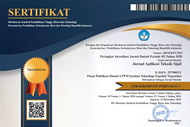Analisis Derajat Kerusakan dan Penurunan Modulus Elastisitas Material Cement Treated Base (CTB) menggunakan UPV test dan Concrete Quality Designation (CQD)
Abstract
Keywords
Full Text:
PDFReferences
H. C. Hardiyatmo, Perancangan Perkerasan Jalan & Penyelidikan Tanah. Yogyakarta: Gadjah Mada University Press, 2015.
B. G. E. Halsted, D. R. Luhr, and W. S. Adaska, “Guide to Cement-Treated Base ( CTB ).” Portland Cement Association (PCA), Illinois, 2006.
A. Ismail et al., “Laboratory investigation on the strength characteristics of cement- treated base,” Appl. Mech. Mater., vol. 507, pp. 353–360, 2014, doi: 10.4028/www.scientific.net/AMM.507.353.
K. Nusit, P. Jitsangiam, J. Kodikara, and H. Bui, “Cyclic Loading Responses of Cement-Stabilised Base Material: An Investigation on Moduli for Pavement Design,” in The 12 Australia New Zealand Conference on Geomechanics, 2015, no. February.
S. Lim and D. G. Zollinger, “Estimation of the Compressive Strength and Modulus of Elasticity of Cement-Treated Aggregate Base Materials,” Transp. Res. Rec., vol. 1837, pp. 30–38, 2003.
K. P. George, “Cracking in Cement-Treated Bases and Means for Minimizing It,” 47th Annu. Meet. Highw. Res. Board, pp. 59–71, 1968.
P. E. Fossberg, J. K. Mitchell, and C. L. Monismith, “Cracking and Edge-Loading Effects on Stresses and Deflections in a Soil-Cement Pavement,” Highw. Res. Rec., 1972.
A. Sounthararajah, H. H. Bui, N. Nguyen, P. Jitsangiam, and J. Kodikara, “Early-Age Fatigue Damage Assessment of Cement-Treated Bases under Repetitive Heavy Traffic Loading,” J. Mater. Civ. Eng., vol. 30, no. 6, 2018, doi: 10.1061/(asce)mt.1943-5533.0002250.
K. Nusit and P. Jitsangiam, “Damage Behavior of Cement-Treated Base Material,” Procedia Eng., vol. 143, no. Ictg, pp. 161–169, 2016, doi: 10.1016/j.proeng.2016.06.021.
W. Uddin, R. M. Hackett, A. Joseph, Z. Pan, and A. B. Crawley, “Three-dimensional finite-element analysis of jointed concrete pavement with discontinuities,” Transp. Res. Rec., no. 1482, pp. 26–32, 1995.
A. M. Zainuri, Kekuatan bahan. Yogyakarta: Penerbit Andi, 2008.
T. F. Fwa, The Handbook of Highway Engineering. Boca Raton: CRC Press, Taylor & Francis Group, 2006.
FAA, “AC 150/5370-10H, Standard Specifications for Construction of Airports,” 2018.
T. H. Panzera, A. L. Christoforo, F. de Paiva Cota, P. H. Ribeiro Borges, and C. R. Bowen, “Ultrasonic Pulse Velocity Evaluation of Cementitious Materials,” Adv. Compos. Mater. - Anal. Nat. Man-Made Mater., no. May 2014, 2011, doi: 10.5772/17167.
B. Bolborea, C. Baera, S. Dan, A. Gruin, D. D. Burduhos-Nergis, and V. Vasile, “Concrete compressive strength by means of ultrasonic pulse velocity and moduli of elasticity,” Materials (Basel)., vol. 14, no. 22, pp. 1–16, 2021, doi: 10.3390/ma14227018.
W. de A. Thomaz, D. Y. Miyaji, and E. Possan, “Comparative study of dynamic and static Young’s modulus of concrete containing basaltic aggregates,” Case Stud. Constr. Mater., vol. 15, no. June, p. e00645, 2021, doi: 10.1016/j.cscm.2021.e00645.
F. Saint-Pierre, A. Philibert, B. Giroux, and P. Rivard, “Concrete Quality Designation based on Ultrasonic Pulse Velocity,” Constr. Build. Mater., vol. 125, pp. 1022–1027, 2016, doi: 10.1016/j.conbuildmat.2016.08.158.
PCA, “Soil Cement Laboratory Handbook,” Portland Cement Association. Portland Cement Association (PCA), Illinois, 1992.
SNI1743:2008, “Cara Uji Kepadatan Berat Untuk Tanah.” Badan Standardisasi Nasional Indonesia, Jakarta, 2008.
ASTM D1633, “Standard Test Methods for Compressive Strength of Molded Soil-Cement Cylinders.” American Society for Testing and Material (ASTM) International, 2000, doi: American Standard Testing Methods.
SNI 8141:2015, “Spesifikasi lapis pondasi agregat semen (LFAS).” Badan Standardisasi Nasional Indonesia, Jakarta.
P. K. Mehta and P. J. M. Monteiro, Concrete : Microstructure, Properties, and Materials, Third. McGraw-Hill Companies, 2006.
ACI, “Nondestructive Test Methods for Evaluation of Concrete in Structures,” Farmington Hills, MI, USA, 2013. doi: 10.14359/51686889.
ASTM C597-02, “Standard test Method For Pulse Velocity Through Concrete.” American Society for Testing and Material (ASTM) International, West Conshohocken, PA, U.S., 2002.
Direktorat Jenderal Bina Marga, Manual Desain Perkerasan Jalan. 2017.
ASTM C469-10, “Standard Test Method for Static Modulus of Elasticity and Poisson’s Ratio of Concrete in Compression.” 2010.
S. Amirkhanian and M. Corley, “Characterization of Bases and Subbases for AASHTO ME Pavement Design,” no. FHWA-SC-21-01, p. 149, 2021.
M. Ba, M. Fall, and J. Tinjum, “Comparison of Laboratory Resilient Modulus with Elastic Moduli measured with Soil Stiffness Gauge and Back-Calculated from Large Scale Model Experiment of Unbound Base Course,” Int. Conf. - Innov. Constr., no. May, 2015.
DOI: http://dx.doi.org/10.12962%2Fj2579-891X.v21i4.18629
Refbacks
- There are currently no refbacks.

Jurnal Aplikasi Teknik Sipil by Pusat Publikasi Ilmiah LPPM Institut Teknologi Sepuluh Nopember is licensed under a Creative Commons Attribution-ShareAlike 4.0 International License
Based on work at https://iptek.its.ac.id/index.php/jats




